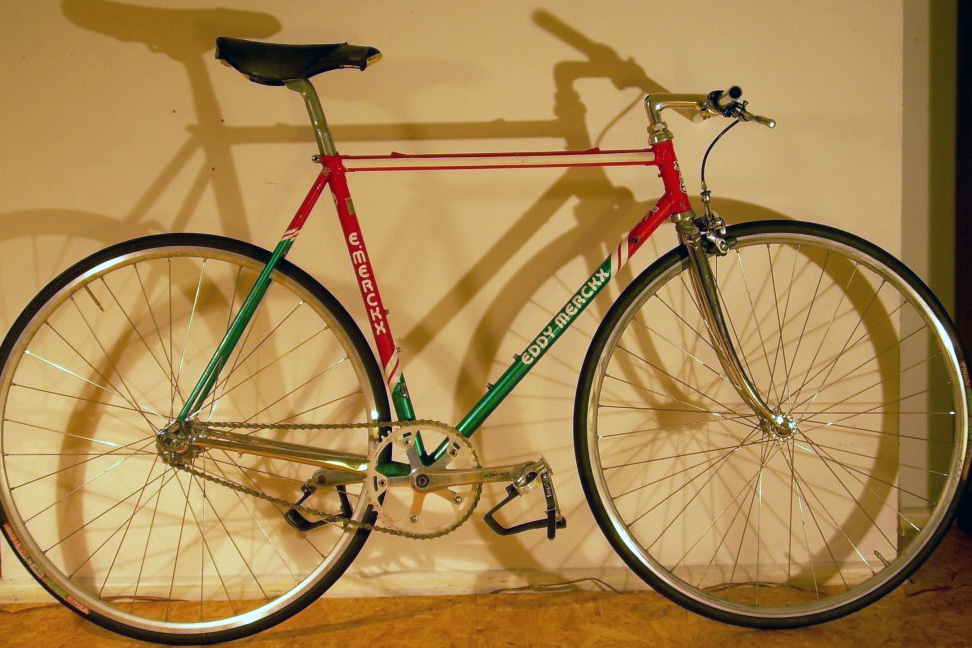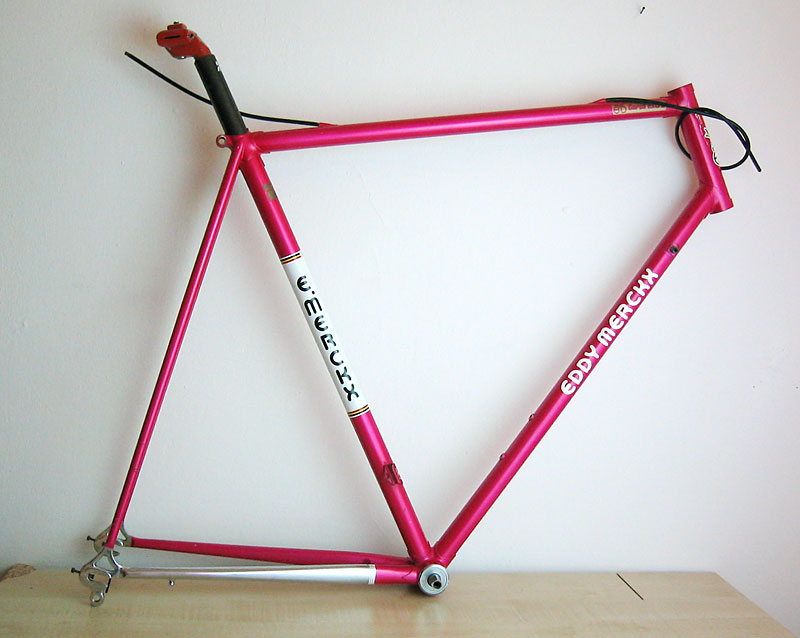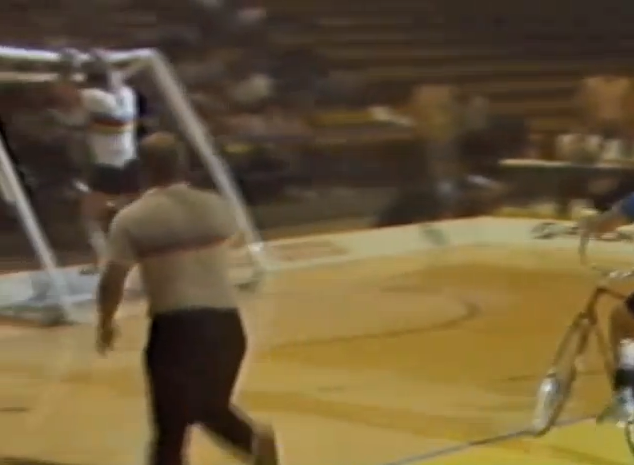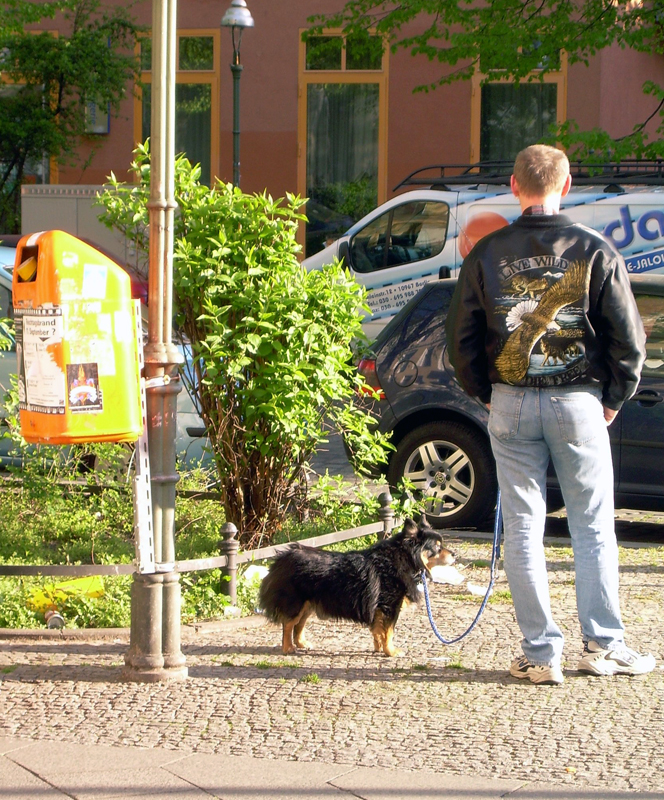Owen Mulholland
In his first year as a professional (1965) Eddy Merckx was asked the not unusual question for a neo-pro, "What are your principal ambitions as a racing cyclist?" The answer was immediate: "To win the Tour de France and set a new Hour record.
Americans with any interest in cycling will recognize the Tour de France and know enough to appreciate what winning it means. But to mention the hour record in the same breath with the Tour may leave some people perplexed. How can an event lasting in excess of a hundred hours over three weeks be equated with one of just sixty minutes' duration?
Many activities have a popular face enjoyed by all sorts of devotees, and another face, less well known, one held dear in the hearts of practitioners and ardent aficionados. The Tour, the largest annual sporting event in the world, is that popular face. Millions of fans line the route it travels and millions more catch it on television. It purposely seeks out a complete gamut of difficulties to reveal its winner as a master of road cycling. Already winner of the World Amateur Road Championship (at age 19 in 1964) Eddy Merckx had every right to dream of where his talent could take him in the theater of the road. In addition, no Belgian had won the Tour since 1939. Belgium had the reputation of being able to produce one day winners, men who could turn it on in the classics, but who were nowhere over the long haul. Eddy was on a dual mission of personal fulfillment and national revival.
Of necessity, the Tour, like all road races, demands as much pondering as power. The mix of pure athleticism with guile, a sort of chess game at speed, makes the Tour what it is. But what is a rider’s worth in terms of pure power? Strip away that guile, that wily knack of knowing when to attack, and what’s left?
There are a number of ways to force a rider to reveal the answer. It’s for this reason that time trials are called the "race of truth". Yet even here weaknesses can be masked. Jacques Anquetil, his era’s master against the watch, was beaten in a 1960 Tour of Italy time trial by an opponent’s suicidal descending skills. Or how often have weather conditions dramatically changed between the beginning and finish of a t.t. thus handicapping one end of the start sheet? Lucian Van Impe (1976 Tour winner) did very well in time trials with a hill, but faded on the flat. And so on. Time trials on the road will always be bound to their time and place.
What is needed is a purely neutral territory, one that leaves the rider naked vith no place to hide behind peculiar attributes or happenstance. In cycling there is only one such place, a velodrome. The absence of wind, the regularity of terrain, and the depth of self-knowledge necessary to maintain a near peak effort for sixty minutes have chopped through the ranks of great cyclists like a tsunami across a coconut festooned atoll. Only the strongest remain. Of the thousands of bike racers who have made it to the professional level during the last 98 years, only 19 have set a new standard for the Hour. And that is why an insider such as Eddy Merckx appreciated this face ofcycling. In 1965 only 15 had held the Hour record. This was a very exclusive club, much more so than the list of Tour de France winners, and therefore a natural goal for Eddy.
Although Eddy Merckx went on to create an incomparable road record, he was equally adept on the track. As an amateur he tried everything on the nearby Belgian indoor velodromes of Ghent and Antwerp, even match sprinting. As a professional he won no less than 17 six day races and contested many more. In short he had no fear of the banked boards. Unquestionably a certain knack is needed to ride the track successfully. Some giants of cycling, such as Bernard Hinault, never could adapt to track riding.
Feeling his destiny in the Hour record was not enough for Merckx. However rare such sentiments, that was almost the easy part. For a man of his stature, so much in demand, time became the great barrier. Year after year he raced 200 times or more. Nor was all this activity just to devour his competitors, as his nickname, the "Cannibal", implied. He would have loved to spend more time at home, especially during the winters, but he found it impossible to resist the argument that if he didn’t show up for the six-day races the attendance would be low and his less famous colleagues would ride for a reduced amount. Never has the sport seen a finer example of professional responsibility. (And it is from this position that his recent critiques of Greg LeMond have been made.)
By 1969 he had won both the Giro and the Tour, along with Paris-Roubaix and the World Championships; he knew he had the physical maturity for the Hour. Then late that season his leg was broken in a motor paced criterium putting finis to any record hopes.
It wasn’t until 1972 that Merckx decided to include the Hour in his season’s plans. The general idea was to ease up on the number of races so he would have energy enough to do the intense preparation required. In practice he kept pretty close to his normally full schedule. During the year he won no less than fifty (50!) races, among them a fifth Milan-San Remo, a fourth Tour de France, a third Tour of Italy, a third Liège-Bastogne-Liège, a third Fleche Wallone, a second Tour of Lombardy, etc.
During the Tour he acquired a saddle sore which needed time off the bike. It was during his forced convalescence in August that he began to seriously contemplate the Hour. The "how" would be broken into two parts, physical and technical preparation. The other question was "where"?
Many continental riders care little about the machinery they ride, but, as in many things, Merckx was an exception. His attention to detail bordered on the fanatical. He it was who designed his hour record bikes and.comparable road frames. In general, the frames were more upright and the resultant position was more forward. Merckx’s friend and sponsor, Ernesto Colnago, quickly translated Eddy’s ideas into orange tubed reality. From mid-September on he used the road frames exclusively, explaining: "I am, above all, a roadman. I shall attack the record as a roadman must. I must finish the season at the peak of my road form, for that is how I shall have the best chance of beating the Hour record."
It is interesting to note that Eddy now moved into a realm that comes only rarely even to the most gifted and dedicated in any endeavor. At that first outing on his new bike, the Tour of Piedmont in Italy, he intentionally attacked with almost fifty miles to go. This solo ride was done to test himself. Any references to rivals had been left behind. In 1980, the French cycling magazine, "Miroir du Cyclisme", published a tribute to Eddy which captures such periods of his career:
La victoire ne luis suffisait pas.
Il lui fallait l’exploit et la légende.
Plus que contre ses adversaires,
qu’il battait et battait encore,
Eddy Merckx courait contre lui-même,
a la recherche d’un absolu,
qu’il atteignt parfois.
For him victory was not enough.
He needed to create exploits and legends.
More than against his adversaries,
whom he beat time and again,
Eddy Merckx raced against himself,
searching for an absolute
that he attained from time to time.
So while Eddy continued to win big and little races throughout the fall (including two times in Lausanne and once at Sallanches all on the same day!), for him these were all part of a larger plan to arrive at the Hour attempt with the best possible form.
If things went according to plan in the technical and physcial realms, the apparently simple matter of where became progressively more complex. In 1968 the Danish rider, Ole Ritter, opened the consciousness of modern cycling to the possibilities of high altitude by setting a new record of 48.654 km. at Mexico City. (I say "modern consciousness" because W.W. Hamilton made the second largest increase in the distance covered during the Hour in 1898 in Denver, Colorado.) That left Eddy torn between the traditional site of the Vigorelli track in Milan, Italy, and the obvious advantages of Mexico.
The Vigorelli was attractive bacause it involved little travel, would allow direct comparison with all but two previous Hour record holders going back to 1935, and would more readily satisfy the publicity demands of his Italian sponsors, notably Molteni sausages. But a trip to the Vigorelli on October 12 was disappointing. Days of rain left the track saturated and unfit for cycling.
Immediately Eddy began to think of Mexico. There were three principal reasons against such a trip and one for it. 1- He was well aware of Ferdinand Bracke’s disasterous attempt in Mexico in 1969. Bracke had set the record in 1967 and this was his attempt to retake it from Ritter, but the thin air asphyxiated him. Eddy’s solution was to ride a home trainer every day while hooked up to an air mixture equivalent to Mexico City. 2- Compared to the record itself publicity meant nothing. Eddy was to ultimately pay over $20,000 of his own money to fulfill his purist dream. 3- The third objection, regarding comparisons to previous winners, would be taken care of by the one major asset of Mexico, the air’s thinness. Eddy meant to set a record that would be so inaccessible no one would dispute its worthiness.
At last departure day came. Eddy and his retinue flew from Brussels to Mexico City via Montreal, a 13 1/2 hour flight during which Eddy drank a couple whiskeys and slept not at all. At one a.m., Mexico time, he was in bed, and eight hours later he took his first look at the Olympic velodrome.
He showed no trace of fatigue. Indeed, after a few test laps he decided to gear up from his 52X15 to 52X14. (Only Jacques Anquetil had used a higher gear, 52X13, during his non-homologated attempt in 1967.) The Belgian felt so good he drew up a schedule for a preliminary ride to break records at 5, 10, and 20 kms.
Then disaster struck. A tropical deluge engulfed Mexico City that afternoon and left the track unrideable the following day. So Eddy went to the Mexico City sports car circuit to train behind a derny (and escape that city’s infamous traffic). That afternoon the rains came leaving the track soaked once again. Desperation began its insidious insertion into the psyches of the Merckx entourage.
Day three, Tuesday, found the track unusable once again, but the forecast called for clearing weather. In the morning Eddy did some laps at the motor circuit, and that evening finally got in some more track time. Jean Van Buggenhout, Eddy’s manager, favored an evening attempt. Often the air was calm at that time, if there hadn’t been rain the track was at its driest, and humidity was up a few percentage points then which vould help offset the dry throat rarefied atmosphere frequently imparts to people. On the other hand, the Molteni team doctor, Dr. Cavalli, noted that the air could be perfect in the morning too, and such a time would avoid pushing Merckx against his biological clock. 8 p.m. in Mexico corresponded to 3 a.m. back home.
The weather was the critical factor. Merckx decided to try the next morning, Wednesday, October 25, 1972. Furthermore, he gave up the idea of a special attempt at shorter distances. Rather, he decided to grab the 10 and 20 km. records along the way. His friends were aghast. Even.that great gambler, Anquetil, warned him about an overly rapid start that would leave him vulnerable to any letdown late in the ride. As sportsmen often do, Jacques spoke bluntly when he told Eddy, "Don’t kill yourself and blow up afterwards." Jacques even related a story told by his pal and rival, Roger Riviere, when Roger attacked his own Hour record in 1958. Riviere had a special pocket made in his track jersey to hold a small plastic bottle of water. From it a tube was taped up the inside of his jersey. All Roger had to do was tilt his head and suck on the tube in order to moiturize his mouth and throat. But after his ride Riviere admitted he’d never taken a sip, even though desperately thirsty towards the end. The slight change in focus could have altered his tempo and he dared not risk even the least slip. If Riviere, a world pursuit champion and previous Hour record holder, couldn’t bring himself to even change his head angle, how could Merckx think about starting at a 50 plus kph pace? Talking about anyone else such insight might have applied. But Eddy was Eddy. The thought of starting at express speed excited him. "Excellent", he muttered more to himself than those present after reviewing a chart equating each 5 km. increment to time and speed, "I must suffer during the opening kilometers." Maybe he even dreamed of pushing the record over 50 kms.
At five the next morning Eddy was up and pounding on doors (No less than 53 journalists had accompanied him to Mexico.) He breakfasted on toast spread with a favorite cheese brought from home, ham, and coffee. By 6:50 he was at the track and by eight he had completed his warmup and was ready to go. In that hour over 2,000 people, alerted by Radio Mexico, rushed to witness this historic sixty minutes. Also watching were Belgian ex-King Leopold, Princess Liliane, and their daughters, Esmeralda and Maria Christina. They eschewed the royal box for banking seats; "The better," Leopold explained, "to appreciate the ride."
At the last moment Windsor stickers were slapped on Eddy’s otherwise unlabeled bike. A distracted Merckx saw this as an acceptable way to thank his Mexican hosts (Windsor is a Mexican bike), but Colnago was infuriated.
At 8:56 exactly, Eddy Merckx began his great ride. A bell was sounded each lap. If he were on schedule he should be crossing the start line as it sounded. After the first two laps Eddy was a quarter lap up! Giogi Albani, who had the job of standing where Merckx actually was when the bell was rung, had a hard time keeping up!
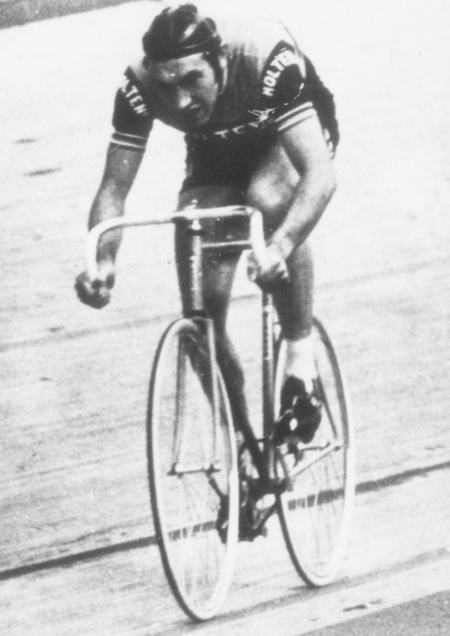
Merckx’s first kilometer passed in 1’10" and five kms. in 5’55.7″. Already Eddy was 14 seconds up on Ritter’s record to this point. Onlookers couldn’t believe their eyes. A second five kms. in. 5’58" obliterated Ritter’s ten km. time by five seconds. Ritter’s 20 km. time was eclipsed by eleven seconds. And remember, Ritter had set his records on a special ride separate from his Hour attempt. Compared to Ritter’s Hour pace, Merckx was 35″ ahead at 20 km.
Albani urged Merckx to slow a bit, and he did, dropping to a 6’7″ per 5 km. pace for the next seven 5 km. segments. Around km. 35 Merckx showed signs of being human. He fidgeted on his seat and the grimace on his face revealed the superhuman effort he was making. There was never a question of his taking the record; the only question was by how much. Far from fading, his last two kms. were reeled off in 1’13" and 1’12"
Still, he could barely speak when he first dismounted. Pictures of the moment show his face a mask of pain. It wasn’t long, though, before Eddy regained is normal composure and was able to answer questions.
"Throughout this hour, the longest of my career, I never knew a moment of weakness, but the effort needed was never easy. It’s not possible to compare the Hour with a time trial on the road. Here it’s not possible to ease up, to change gears or the rhythm. The Hour record demands a total effort, permanent and intense, one that’s not possible to compare to any other. I will never try it again. There are those who told me that if I came here to Mexico I wouldn’t feel the pedals. I assure you, I could feel the pedals! Nevertheless, I don’t regret this choice. I don’t think I could ever improve on this record. Yet I am convinced that one day my record will be beaten. That is the law of the sport. But to beat it it will be necessary to push a bigger gear. My 52X14 was plenty big for me. For five or six kilometers it didn’t pose a problem, but for a whole hour it was very much otherwise."
He reflected further, and then wondered if possibly he couldn’t have done better if he hadn’t started so quickly. If he entertained such thoughts seriously, it wasn’t for long. Eddy Merckx never attempted the Hour again.
In 1984 Francesco Moser added over a kilometer to Eddy’s distance for the hour. While Moser’s performance had great athletic merit it was also assisted by major advances in streamlining. Merckx felt that for the first time the Hour record had been devalued. For the first time personal fitness had not been the sole criterion for a new record. In defeat Merckx had always been a fair man. But this time he remained unconvinced. After all, he had beaten Moser in every time trial in which they had met. His disgust with the purety of the Hour record was obvious, when, commenting on Moser, he said, "For the first time in the history of the Hour record a weaker man has beaten a stronger man."
The technical side of the sport may be controlled, but not stopped. The search for more speed will continue by every means. There was a time, back at the beginning of the sport, or like today in mountain bikes, when the event was supposed to test the man and the machine. Then the bikes became more a neutral factor and riders dominated because they were better. Now we’re headed back toward races in which the man and his (her) bike are tested. Eddy’s Hour record stands as the apotheosis of human effort on a bike. We may never again be able to judge a rider’s ability as we did that of Eddy Merckx in 1972. And when that judgement was made we knew we had seen the finest cyclist in his finest hour.

